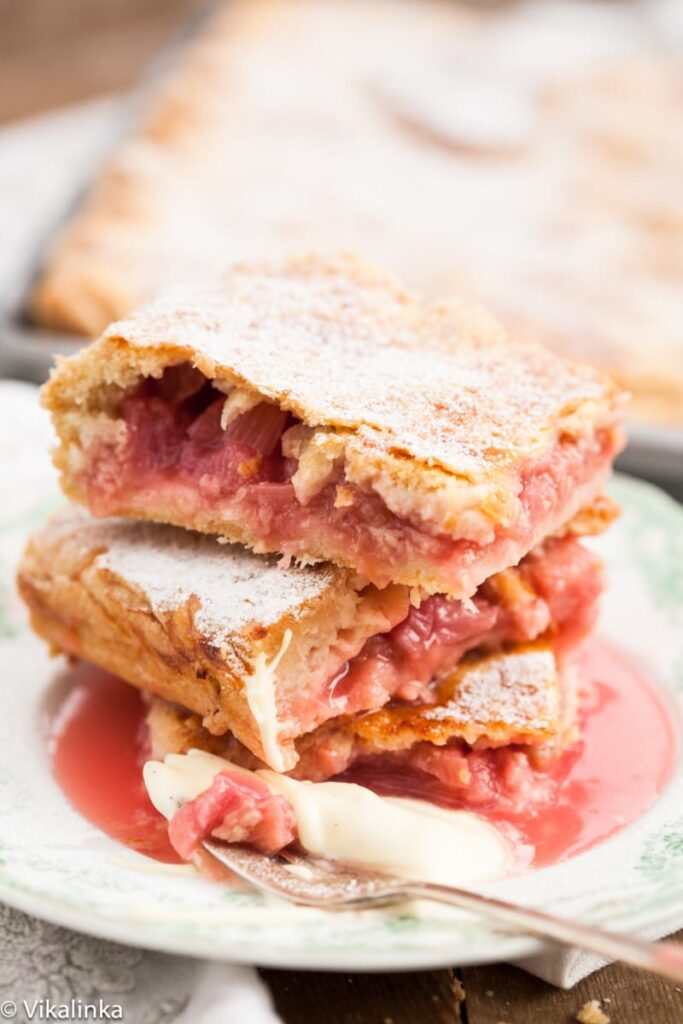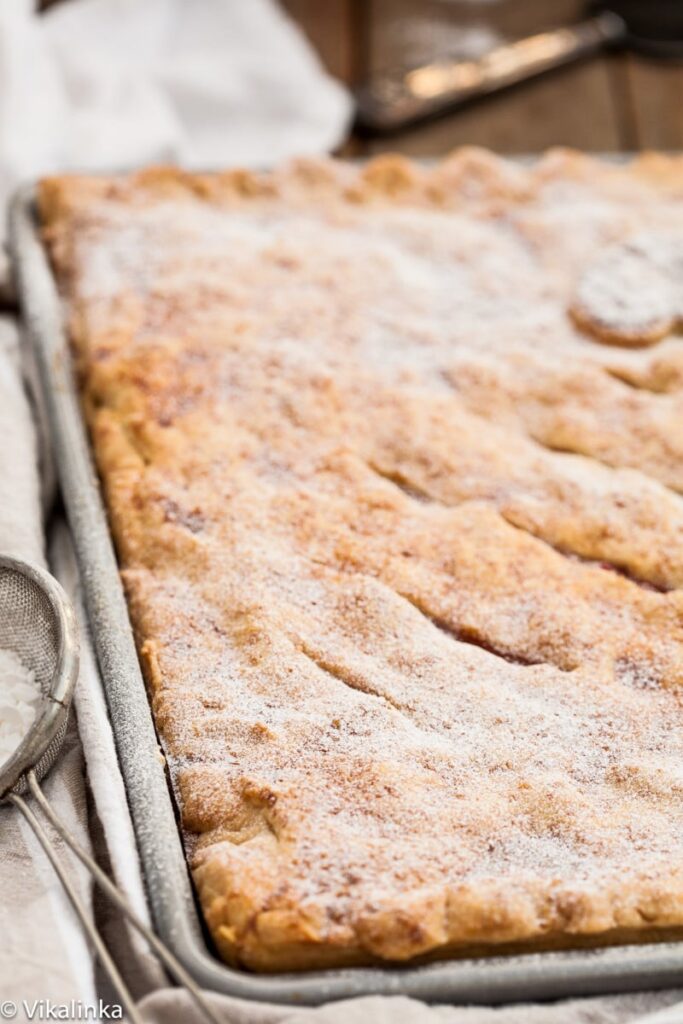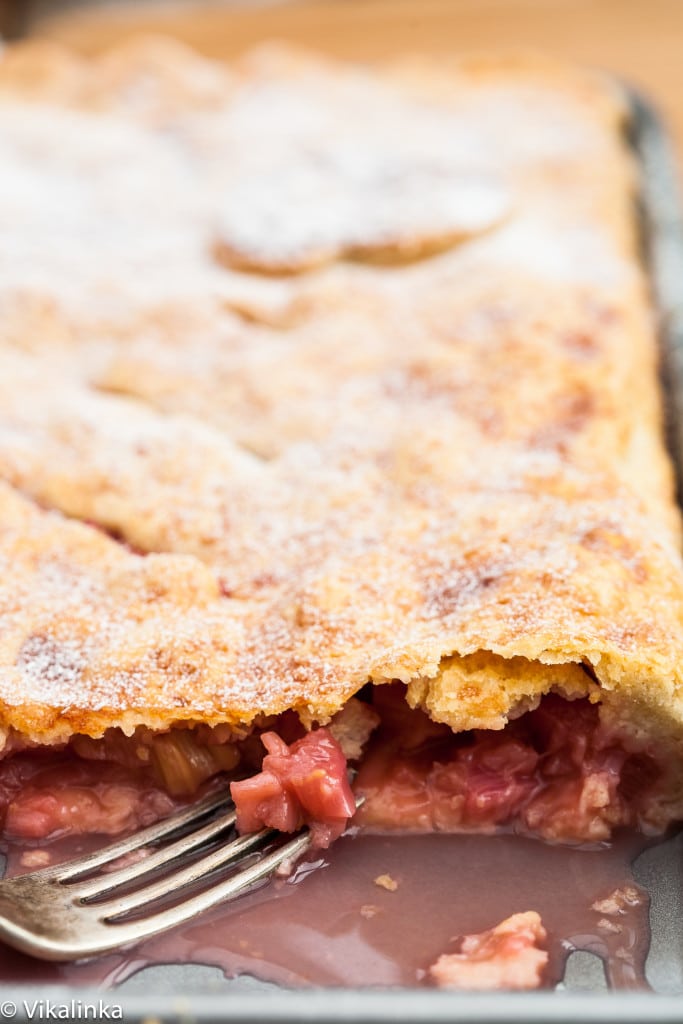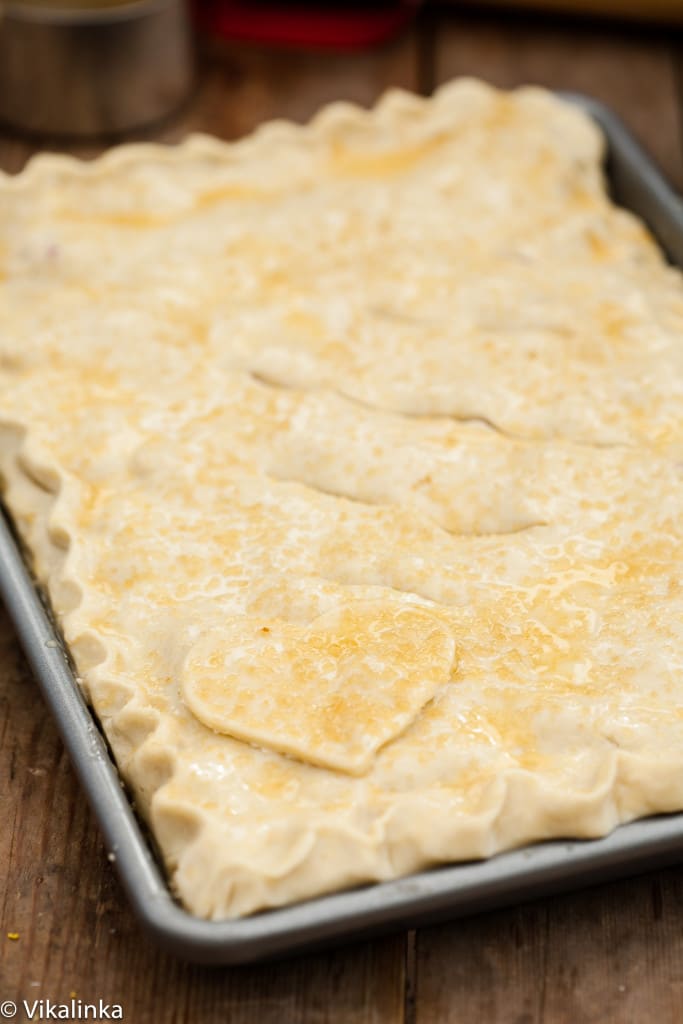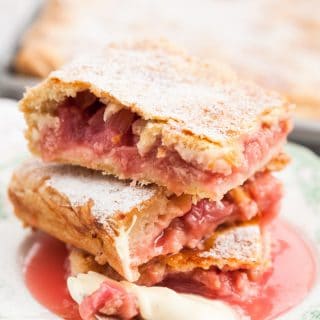For big rhubarb fans, try this Roasted Rhubarb Bakewell Tart. Absolutely heavenly! As the seasons change and the days get warmer, it becomes easier to find lovely rhubarb in shops and markets. And how glad I am! That means that we are into pie season, which for my money is the best way to use rhubarb. For something so crunchy, it is remarkable how rhubarb becomes so tender and juicy when baked. The tart flavour mellows out, resulting in a luxurious syrupy filling that always hits right.
I wanted an easy way to prepare a beautiful batch of rhubarb and so came up with this rhubarb slab pie. As easy as it is delicious, this is a recipe you’ll come back to time and again!
Slab pie
For some reason pies seem like a lot of work. Everything from making pastry to preparing that filling seem so labour intensive. But not so if you use pre-made pie pastry and choose an easy fruit to work with. Also, making your pie into a slab pie helps a lot. A slab pie takes the idea behind a traditional pie and scales it up by baking in a sheet pan or baking dish. They are generally bigger than traditional pies and are easier to make due to their rectangular shape. Less work, more pie. It’s a win-win. However, if you feel like spending some quality time in the kitchen I’ve got the flakiest and the tastiest (read comments under the post) pie crust recipe posted.
What is rhubarb?
We commonly think of rhubarb as a fruit but it’s actually a vegetable. It grows perennially as a low bush with thick stalks and large green leaves. Rhubarb originally came from Asia but grows well in cooler climates around the globe. Only the stalks are eaten. The leaves are lightly toxic and are therefore discarded. There are many different varieties, usually categorised as red, green or speckled. Red rhubarb is often seen as more desirable because of a more vivid colour, but it actually isn’t any sweeter or better for baking than other varieties. The best season for rhubarb is in the springtime from April to June, although this can shift in different locations. A technique called forcing can be used to grow rhubarb out of season.
With forced rhubarb, light is kept away from the crown of the plant, which triggers the growth of the stalks as the plant looks for a light source. Forced rhubarb can be more tender and sweet with a pinker colour when cut open.
Rhubarb recipes
There are few things I like better in baking than rhubarb. Just chop it up, toss with sugar and add to almost any baking recipe for something spectacular. Rhubarb and I go way back so it’s something I have in my kitchen quite a lot. I even baked a traditional Russian cake Sharlotka and instead of using apples, I used rhubarb. Rhubarb is often mixed with strawberries or other berries in desserts. This is because rhubarb is not sweet on its own but when mixed with something sweeter, the sour taste of rhubarb mellows out and becomes the ultimate sweet-and-sour combo. I quite like the pure taste of it, so I decided to leave it alone and let it shine in my rhubarb pie.
Making the pie
The lengthy pie making task I was avoiding for a few weeks was done in no time, 20 minutes to be exact-from the beginning to the end, not counting the oven time. I bought my pastry already rolled into big rectangles. All I had to do was fill them with chopped rhubarb mixed with sugar, flour and lemon zest and pinch the edges so not a drop of tasty filling would spill out.
Then brush it with a bitten egg and sprinkle with some Demerara/Turbinado sugar for extra prettiness. Pop it in the oven for 45 minutes, then dig into it straight away or wait for it to cool if you have that kind of self-control. I don’t.
Recipe tips and notes
To choose the best rhubarb, look for stalks that are firm and crisp. Wilted or woody stalks indicate freshness. Contrary to popular belief, the colour of the stalks isn’t a big indicator of sweetness. Often the rhubarb we see in shops or magazine photos is forced rhubarb, which is a technique for growing it that limits the light going to the crowns and encourages early growth. It has a pinker colour inside than homegrown rhubarb, but either forced or homegrown are great for baking. There is no need to pre-cook the rhubarb for this pie. Just dice the rhubarb into small enough pieces and they will cook perfectly inside the pastry while the pie is baking. Allow the baked pie to cool for at least an hour before cutting into it. While it can be cut right away, the filling will likely stream out. Letting the pie cool will give the filling a chance to settle and solidify. Baking recipes with rhubarb are at their best when served with ice cream or whipped cream. A bit of added creaminess is heaven next to tart rhubarb!
Storage and leftovers
To store any leftovers, cover in plastic wrap or in an airtight container if you have one large enough. Because there are no dairy products in this pie, it doesn’t have to be refrigerated and can be left at room temperature for up to two days. If in a fridge, it will last up to four days. Pie can also be stored in a freezer by adding when it has fully cooled and leaving it uncovered until frozen all the way through. When fully frozen, it can be covered with plastic wrap and left for two months. The pie is very tasty at room temperature but can also be warmed up if you like that better. Simply add it to an oven preheated to 180C/350F for ten minutes.
